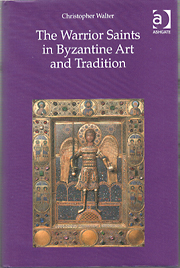

The Warrior Saints in Byzantine Art and Tradition,

Christopher Walter is well known as an authority on Byzantine iconography, and has some worthy publications in that area. His introduction to The Warrior Saints suggests that this volume came about as a necessary precursor to a notional project to assemble a comprehensive treatment of the iconography of warrior saints. As Walter says at the outset ‘To define what a warrior saint was in the Byzantine tradition is seemingly simple: he was a saint who was a warrior. However, once one plunges into the enormous literature in which they figure, difficulties arise.’[1] The problematical literature begins with the very Byzantine sources, and has been not been much improved by modern scholars.
The warrior saint as cult and literature is largely a phenomenon of the ninth century onwards, yet the saints themselves are overwhelmingly attributed to late antiquity. Walter attempts to resolve the fundamental question of definition by first discussing the late antique and early Christian background. The effect of this chapter is primarily to show how alien (human) warrior sainthood was to both the general social situation of the Later Roman Empire, and, indeed, to early Christians. The latter is not so surprising, since that field of piety was very well served in the first century of the Common Era by a plethora of pagan warrior gods, the so-called “Rider Gods” that are particularly known from popular monuments and stelai from the south-eastern provinces of Anatolia. Deified Emperors also partook somewhat of this militant sacrality.
Following that, Walter catalogues the saints who are at times categorised as warriors, beginning with the category of the “Major Estate” of well known saints defined by earlier modern scholars, and then collecting lesser known saints with military associations. Time again the author tries to distinguish between some sort of “historical background” and later pious literature, and time and again he must concede defeat, and conclude that the great majority of warrior saints are fundamentally fictitious. This being the case, the medieval literature on these saints is of no use to historians interested in the late antique period in which most of the warrior saints are supposed to have lived. Even in those few cases when the saint is believed to have lived in an era more proximate to the ninth to eleventh century period which dominated warrior hagiography, their Lives add nothing of significance to the secular or chronicle sources for those times.
I said earlier that I suspected that this treatment of the literary and ideological underpinning of warrior sainthood was the background to a study of iconography, yet is impossible to completely separate the realms. Unfortunately, the treatment of the depictions of saints is a greater disappointment. It must be acknowledged that a comprehensive collection of the art of warrior sainthood would be a much larger project than this volume, and if it could be realised might well be prohibitively expensive, given the cost of reproducing pictures, but it is something to be fervently wished for. The failings of this volume go beyond the scanty and poorly reproduced black and white sampling of pictures. Walter's own characterisation of iconographic elements undermines his understanding of the art. On a several occasions he mentions that the most prominent depictions of sometime warrior saints do not commonly show them in military dress, but in civilian clothes, which he commonly characterises as “court dress”. ( He is probably usually correct in this assessment, although it, too, is an inadequately studied area.) He then tries to resolve this problem by citing the fact that they may be holding a sword as support for their military status. In doing so he takes insufficient account of the fact that the Book of Ceremonies tells us that swords were important part of court regalia, and, indeed, that several ranks were named for this weapon -— Spatharios, Spatharokandidatos and Prôtospatharios. Hence the presenace of a sword cannot really be taken as indicating military status in the era in which the saints’ lives were composed. Recognising this would not have made very much difference to already firm conclusion that the warrior saint is a thoroughly nebulous character who had no definite boundaries in the Byzantine mind.
I fervently hope that Walter does not stop with this volume, and does go on to a more lavishly illustrated treatment of the art of warrior sainthood. As I have argued en passant in various other places,[1] depictions of warrior saints are presently largely unappreciated sources for accurate detail of middle Byzantine military equipment. A more extensive and unified collation of such sources could only assist in the study of Byzantine military technology.
In summary, The Warrior Saint in Byzantine Art and Tradition is very probably a significant contribution to the scholarship on hagiographic studies, but, alas, it is of little or no use to military historians.
[1] ‘Kremasmata, Kabbadion, Klibanion: Some aspects of middle Byzantine military equipment reconsidered’, Byzantine and Modern Greek Studies, 22, (1998) pp. 38 - 50. Republished at http://www.levantia.com.au/military/KKK.html
‘ Suntagma Hoplôn: the equipment of regular Byzantine troops, c. 950 to c. 1204’, David Nicolle (ed.), A Companion to Medieval Arms and Armour (Boydell and Brewer, 2002_, pp. 81-96.
‘ Klivanion revisited: an evolutionary typology and catalogue of middle Byzantine lamellar’, Journal of Roman Military Equipment Studies, 13 (2002, but forthcoming)
